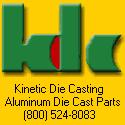The process of making of aluminum cast parts entails value for product quality, above else. With this in mind, aluminum casters tend to give premium on following specifications right to the tilt. The basic agenda on the list is die construction, which is primarily made of aluminum casting tooling. Aluminum casting is made of alloy tool steels in at least two sections, namely the fixed die half and the ejector die half. In modern times, dies may carry cores, movable slides, or other sections for the production of threads, holes, and other features for the attainment of the desired shapes.
The fixed die half has sprue holes that makes it possible for the molten metal to enter the die and fill in the cavity. On the other hand, the ejector die half has runners and gates that lead the molten metal right into the cavity. Aside from these two sections involved in the aluminum casting process, dies also consist of locking pins (for purposes of securing the fixed die half and the ejector die half), ejector pins (for purposes of making the removal of the cast part easier), and openings (for purposes of cooling and lubricating the molten metal or cast).
When the chamber closes, the fixed die half and the ejector die half become one and remain locked together, thanks to the chamber’s hydraulic pressure. After a certain amount of time elapses (depending on the total projected surface area and the pressure required for the injection of the metal into the cavity), the aluminum casting process is completed and high quality aluminum castings parts are produced.



